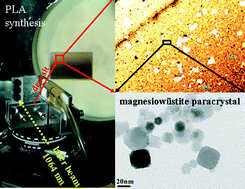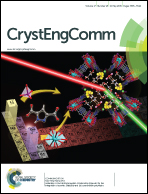Pulsed laser ablation synthesis of magnesiowüstite based phases with special defect clusters, interfaces and internal stress: implications for natural occurrence and engineering applications†
Abstract
Nanocondensates of rocksalt-type (R) magnesiowüstite and minor spinel-type (S) magnesioferrite with paracrystalline distribution of defect clusters were fabricated by pulsed laser ablation of MgO–Fe2O3 solid solution (9 : 1 molar ratio) under specified power densities in air and characterized by X-ray/electron diffraction and optical absorption spectroscopy. The predominant magnesiowüstite nanocondensates have well-developed {100}, {110}, {111} facets for (hkl)-specific coalescence as unity and bicrystal with exact/almost {110} 70.5° twist boundary, {111} twin boundary, (1![[1 with combining macron]](https://www.rsc.org/images/entities/char_0031_0304.gif)
![[1 with combining macron]](https://www.rsc.org/images/entities/char_0031_0304.gif) )/(001) heterointerface, and (100)R/(310)S interphase interface constrained by [0
)/(001) heterointerface, and (100)R/(310)S interphase interface constrained by [0![[1 with combining macron]](https://www.rsc.org/images/entities/char_0031_0304.gif) 1]R//[001]S. The magnesiowüstite nanocondensates have a minimum band gap of ca. 3 eV for potential opto-electronic catalytic applications and a significant internal compressive stress of ca. 2.5 GPa when fabricated at a relatively high power density, shedding light on its natural high-pressure occurrence.
1]R//[001]S. The magnesiowüstite nanocondensates have a minimum band gap of ca. 3 eV for potential opto-electronic catalytic applications and a significant internal compressive stress of ca. 2.5 GPa when fabricated at a relatively high power density, shedding light on its natural high-pressure occurrence.


 Please wait while we load your content...
Please wait while we load your content...